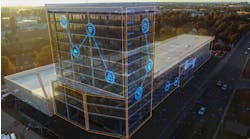It’s easy to lose the efficiency promised by your building controls if they can’t interact with each other, requiring you to juggle multiple interfaces to monitor each building system.
With an integrated building management system (BMS), however, you can bring those controls together into a single comprehensive interface that gives a new meaning to multitasking.
1) Identify Strategic Upgrades
Which building controls will you integrate? It may be cost-prohibitive to pull them all together at once, but the scalable nature of many integrated systems means you can expand them to cover additional systems or buildings as your budget allows.
“It provides one common backbone for everything, and customers can add or take away pieces over time,” explains Greg Turner, vice president of offering management for Honeywell, a systems provider. “You can have one common core platform going forward that will enable you to meet the needs of your business as it changes.”
Depending on the manufacturer, integrated platforms can tie together systems ranging from lighting and HVAC to security, fire detection, and backup power. Many are backward compatible, meaning that you can integrate older systems (sometimes from other suppliers) with minimal investment. This allows you to add functionality without spending more money than you planned.
For maximum versatility, also look for a system that supports multiple standards, such as LONworks and BACnet.
“You can change components of the hardware while leaving the majority of your system in place if you need to,” advises Chris Hollinger, senior product manager of control products and systems for Siemens Building Technologies Division. “People often say ‘I want to keep the old zone controllers because they’re in a space where people are working, but I want new supervisory controllers so I have more capabilities to provide energy-saving activities.’”
2) Streamline for Savings
Develop a plan for maximizing the integrated system’s capabilities. Some providers offer web-based or mobile control, allowing you to monitor and make changes from any location with a Wi-Fi signal or Internet capability.
At the very least, integrating will give you a portal where you can simultaneously examine multiple types of controls and sensors. Decide early on how you will use this information to create efficiencies.
“The applications where you monitor and command the system, understand what’s going on, view alarms, look at trends, and provide scheduling – all of those are done in a uniform fashion,” Hollinger says. “There’s one user interface providing that functionality, which makes it easier to manipulate the system.”
Energy, infrastructure, support, and labor savings can secure a 20-30% reduction in costs, Hollinger says, though results depend on baseline performance and the extent to which you explore the integrated approach.
Higher education facilities and corporate campuses stand to reap dramatic benefits because centralized control lends itself easily to a multiple-building setup. However, the convenience of using one web-based portal for multiple systems offers cost savings for applications of any size.
Miami International Airport, for instance, combined third-party life safety and HVAC controls with its own Airport Operation Information System, a centralized airport operations database, to improve operational efficiency, passenger comfort, and safety.
“Performance buyers buy for uptime and reliability, and the system is mission critical to what they do,” explains Turner. “Cost-conscious customers, like local governments, offices, and school districts, buy it because they see it as a chance to spend money once to get operational cost savings. They can quickly identify bad behaviors or operating procedures.”
3) Keep Your Controls Current
As budget, training, and technological advances allow, you may want to expand or upgrade your integrated BMS. It’s vital to choose a knowledgeable vendor who can match solutions to your challenges, Hollinger explains.
Continuous commissioning can help you stay on top of regular maintenance, a need your integrated BMS shares with any other building system.
“Don’t assume that once it’s commissioned, it will be commissioned for the next 10 years without any changes,” Hollinger says. “Seasons change and needs change.”
Janelle Penny (janelle.penny@ buildings.com) is associate editor of BUILDINGS.



